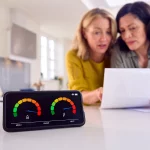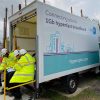Three UK and Huawei Demo 3-4Gbps 5G Wireless Broadband Link
Mobile operator Three UK and Huawei have teamed-up in London to demonstrate a multi-site 5G network, which was able to deliver peak wireless broadband speeds of up to 3-4Gbps (Gigabits per second) via the 28GHz radio spectrum band and 1-2Gbps when using the 3.4GHz band.
In a typical deployment scenario we might expect the 28GHz band to be harnessed for connecting individual premises (i.e. Fixed Wireless Access) because it’s fairly poor at wide area coverage, while 3.4GHz is more likely to be focused on catering for users in a dense urban mobile environment (Smartphone connections etc.).
So far as we can tell the fastest 28GHz test had access to 800MHz of continuous spectrum frequency (4 x 200MHz), while the slower 3.4GHz band test was only harnessing about 100MHz of spectrum. But it’s important to stress that a short-distance demo (conducted on a moving bus – maybe up to c.200-300 metres from the station) is not very reflective of the real-world, where other factors come into play (more on this below).
Advertisement
According to Huawei, their 5G chipset should in the real-world be able to deliver a peak home broadband download speed of 2Gbps (or a max of 1Gbps for single users), although yesterday Three UK wisely tempered that against the reality of network provision (i.e. balancing capacity, demand, interference, distance, power etc.) by saying that they expected end-user speeds of 80-100Mbps (here).
Yang Chaobin, President of Huawei’s 5G Group, said:
“The 5G trials we carried out today demonstrate the opportunity this technology brings to the home broadband market. [We] will continue to work with Three UK to bring customers more market-leading commercial applications of 5G.”
We should point out that both EE and Vodafone have also conducted similar tests earlier this year, which resulted in similar performance. At present Three UK has about 144MHz of 5G friendly spectrum across several different bands, although they have quite a bit near 3.4GHz and that should give them a good block to work with (here).
As usual the first areas to benefit from the start of Three UK’s commercial 5G roll-out later next year will be dense urban locations, exactly like those currently being targeted by Vodafone and EE (here and here).
Mark is a professional technology writer, IT consultant and computer engineer from Dorset (England), he also founded ISPreview in 1999 and enjoys analysing the latest telecoms and broadband developments. Find me on X (Twitter), Mastodon, Facebook, BlueSky, Threads.net and Linkedin.
« ISP Plusnet and John Lewis Broadband Launch Black Friday Offers


















































Comments are closed